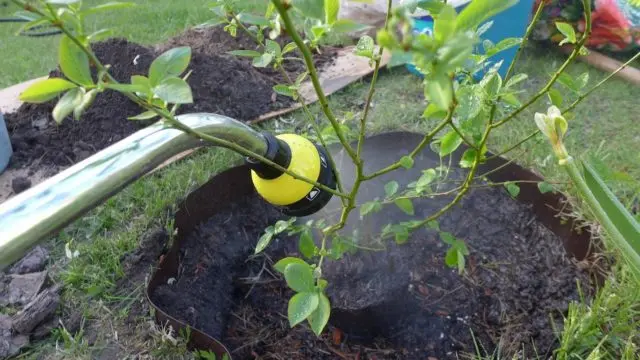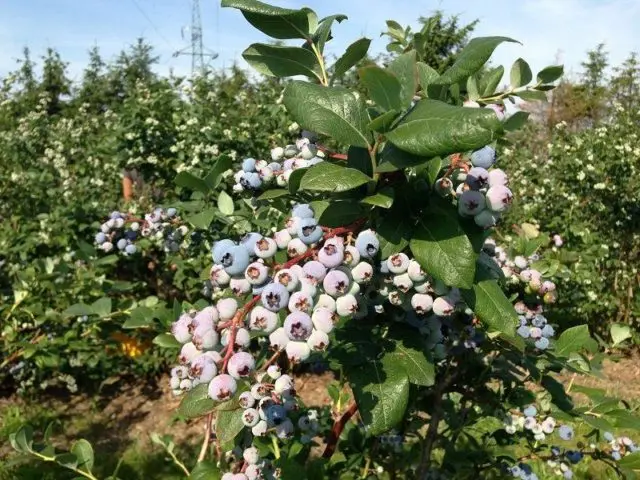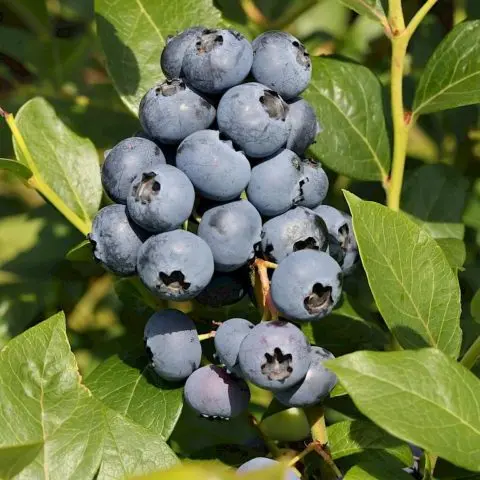Contents
Blueberry Nelson is an American variety, obtained in 1988. The plant was bred by crossing Bluecrop and Berkeley hybrids. In Our Country, the Nelson variety has not yet been tested for inclusion in the State Register. However, the culture is considered promising for cultivation in various regions.
Description of the blueberry variety Nelson
Nelson blueberry is a vigorous shrub that can grow up to 1,5 – 1,8 m in height. Its shoots are straight, raised, numerous. Young shoots are green, with time the bark becomes gray or brownish.
The leaves are smooth, alternate, hard, up to 2,4 cm long. Their shape is lanceolate, with a rounded top. The edges of the leaf plate are slightly bent down. Coloring – bluish-green, on the reverse side – lighter. The leaves have a slight wax coating.
The flowers are located on last year’s shoots, collected in loose brushes. Calyces – bell-shaped, drooping, white-pink. Flowering begins in the second decade of June and lasts 10-12 days. The formation of berries takes 40 – 50 days.
Features of fruiting
Blueberry Nelson is self-fertile, it is able to produce crops without a pollinator. To improve its fruiting, other varieties are planted nearby. A prerequisite is flowering at the same time. For Nelson blueberries, Berkeley, Herbert, Pemberton, Spartan hybrids will be good pollinators.
Harvest variety Nelson ripens from August 10th. Berries ripen in 2-3 sessions. The first wave of fruiting brings the largest and highest quality fruits. The total yield per bush is from 6,5 to 9 kg.
Berries of the Nelson variety have a good sweet and sour taste. Their average dimensions are 18 – 20 mm. The skin is dense, light blue in color. Blueberries hang on branches for a long time, are not prone to falling off and rotting. Fruits withstand long-term storage and transportation.
Berries are rich in vitamins and other beneficial substances. They are consumed fresh, added to dairy products, breakfast cereals. Fruits are stored all winter in dried or frozen form. Delicious home-made preparations are obtained from blueberries: jam and compotes.
Blueberry Nelson in the photo:

Advantages and disadvantages
Benefits of growing Nelson blueberries:
- high stable yield;
- large tasty berries;
- winter hardiness of bushes.
Blueberry Nelson Disadvantages:
- requires soil preparation and a landing site;
- needs acidification of the soil, watering, pruning and other care.
Features of reproduction
Blueberries are propagated vegetatively. Peri transplantation, the bush is divided into parts, the places of cuts are sprinkled with wood ash. Each seedling should have 2 – 3 shoots and strong roots 5 cm long. After planting, the bushes are regularly watered and fed.
For propagation of the Nelson variety, cuttings are also used. In late autumn, cut shoots 10-15 cm long. Strong and large branches are chosen. First, planting material is kept for a month in the cold at a temperature of 1 – 5 ° C. Then the cuttings are planted in a substrate of sand and peat. For 2 years, the plants are watered, fed with complex fertilizers, and then transferred to a permanent place.
Planting and care
When planting blueberries, they observe the deadlines and prepare a place for growing. Be sure to follow the sequence of work.
Recommended dates
Blueberry variety Nelson is planted in autumn or spring. Landing in the spring is considered more reliable. During the season, plants have time to take root and adapt to new conditions. Wait until the soil in the area warms up well. In the middle lane, this is the middle – the end of May, in a colder climate – the beginning of June. In autumn, work is carried out 3-4 weeks before the onset of cold weather.
Site selection and soil preparation
Blueberry Nelson prefers sunny areas. When grown in the shade, the yield drops and the taste of the berries is lost. Best of all, the bush develops in loose, acidic soil. The optimal pH level is from 3,8 to 5. A special device is used to measure it. The groundwater level should not be higher than 40 cm.
If the site is not acidic soil, then you need to prepare a special substrate for Nelson blueberries. They use peat, tree bark or wood chips, needles from a pine forest, sphagnum moss. A good substrate option for blueberries is rotted sawdust.

Landing algorithm
The order of planting Nelson blueberries:
- Dig a hole 50 cm deep and 1 m in diameter.
- If the soil is clayey, pour a 10 cm thick layer of fine gravel or broken bricks onto the bottom.
- The walls of the pit are insulated with boards or sheets of tin.
- The pit is covered with prepared substrate.
- A comb is made on the surface, on which blueberries are planted.
- The roots of the plant are covered with a substrate and watered abundantly.
- Peat or coniferous sawdust is poured into the trunk circle.
Cultivation and care
Caring for blueberries of the Nelson variety comes down to watering and fertilizing. Pruning helps regulate bush growth and yield. In autumn, the plant is prepared for wintering.
Watering Schedule
Blueberries of the Nelson variety are watered sparingly, as the soil dries. On average, moisture is applied 1-2 times a week. Both the lack of water and its excess are detrimental to the culture. The lack of moisture negatively affects the flowering and fruiting of the bushes. With increased soil moisture, the root system rots, and the plant stops developing.
For watering blueberries of the Nelson variety, warm settled water is used. It is poured strictly into the trunk circle. In drought, the bushes are sprayed in the evening, when there is no direct exposure to the sun.
Top dressing schedule
When choosing fertilizers for blueberries, Nelson takes into account the pH level of the soil. If the soil is not acidic enough, this is reflected in the appearance of the plant. The first sign is the reddening of the leaves in spring or summer. If the soil is not acidified, then the development of the shrub slows down, the leaves turn white and fall off, the yield decreases, and the taste of the berries deteriorates.

Nelson blueberry fertilizing options:
- 100 g of powdered sulfur per 1 sq. m;
- 20 g of ammonium sulfate or ammonium nitrate per 1 sq. m;
- 10 g of urea, potassium sulfate or Nitroammophoska per 1 sq. m;
- 10 g of unused electrolyte for cars per 10 liters of water;
- 3 tsp citric acid per 10 liters of water;
- complex fertilizers Florovit, Lifdrip, etc.
In the spring, nitrogen fertilizers are applied under the Nelson variety. Such preparations promote the growth of shoots and leaves. In summer and autumn, they switch to compositions containing phosphorus, potassium, manganese.
Trimming
According to the description, the Nelson blueberry is actively growing. To direct the forces of the bush to the formation of berries, you need to regularly prune. From the second year after planting, 5-7 strong shoots per bush are chosen. The rest of the branches are pruned. Broken, dry, frozen shoots are removed annually.
Preparation for winter
Variety Nelson has a high winter hardiness. Bushes withstand temperatures down to -34 ° C. For the winter, the bush is spudded, a layer of dry leaves or peat is poured on top. A frame is built over young bushes and a non-woven fiber is attached to it.
Pests and diseases
Subject to agricultural technology, blueberries of the Nelson variety rarely suffer from diseases and pests. If alarming signs are found, the shrub is sprayed with fungicides. Against fungal diseases, drugs Topaz, Oksihom, Bordeaux liquid are used. Insecticides Spark and Fundazol help get rid of pests.
Conclusion
Blueberry Nelson is a reliable variety for growing in Our Country. It is distinguished by high productivity, large and tasty fruits, resistance to frost. For growing a hybrid, special conditions are created: they maintain the acidity of the soil, introduce water and fertilizers.










